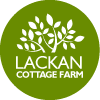2018 is our sixth year on the land here at Lackan Cottage Farm, and although we’ve often had seemingly rapid progress, it is only now that some systems are becoming established enough to produce results. The forest garden area is the best example of this. Sited in what was one of the dampest areas of the field, we planted a mixture of natives – mainly birch and alder, with some oak and rowan, back in the winter of 2012/13, and then added to these in subsequent years. Initially the battle was to find the trees amongst the rushes and grass, but that became easier as the trees grew larger. As they have grown, they’ve dried the ground to the extent that the rushes have retreated, through a combination of the trees taking up moisture, and shading.

The winter of 2017/18 was the first time we were able to prune the lower branches and walk below the trees, which are now providing canopy cover for the apple trees that were planted on their south side and below them. The ground here doesn’t support the apple trees terribly well, so the shelter afforded by the natives is invaluable.
The layer below the apple trees consists predominantly of red and black currants, together with some mint and comfrey. Over late winter we extensively cardboard mulched the entire area to control buttercups, and covered that with a generous layer of manure and compost. Into this we’ve planted a potato crop, and as the year progresses, we’ll introduce increasing numbers of perennials into the surrounding area.

Although its a blurry one. the deliniation between the forest garden area and the vegetable beds and other soft fruit is made with a living willow fence, which has been gradually planted over the last 2 seasons, and which has really seen impressive growth this summer. This will allow us (as we have done this winter) to manage the forest garden with chickens, whilst hopefully preventing them from scratching up our young veg.






